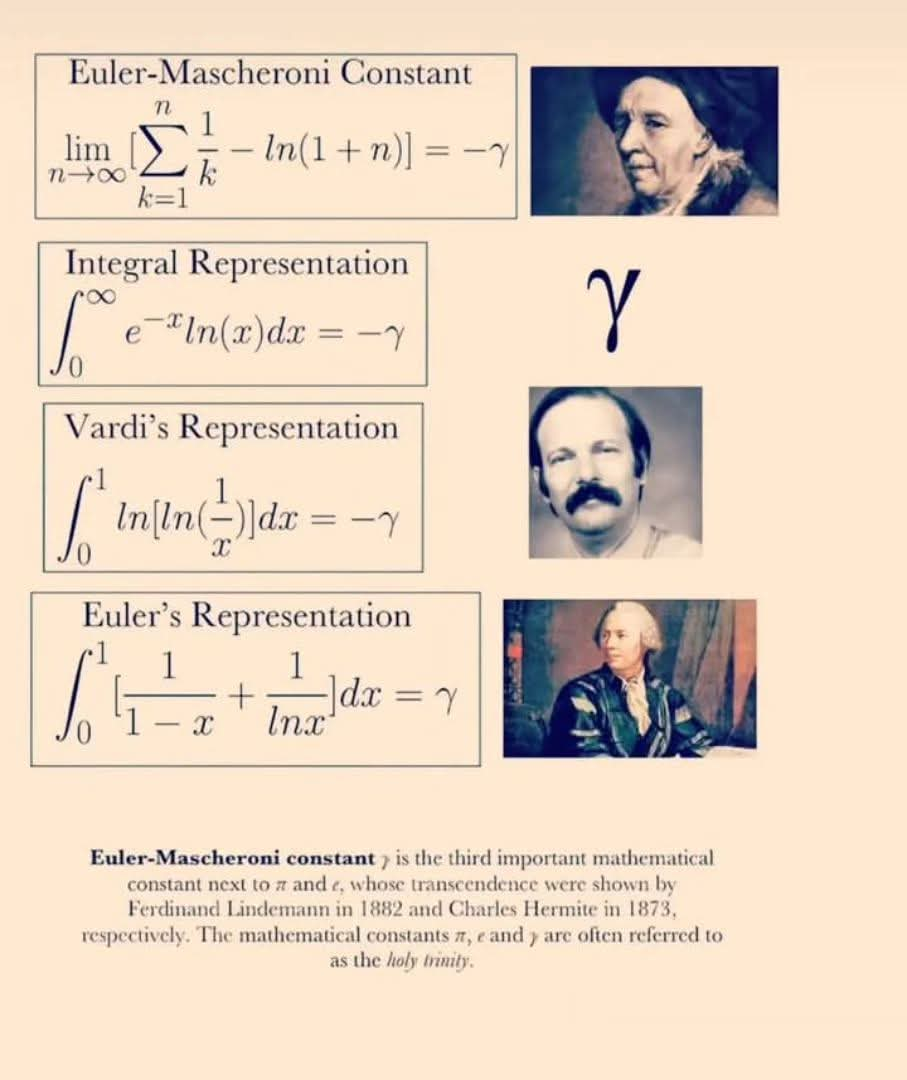Euler-Mascheroni constant, γ (gamma)
- 오일러-마스케로니 상수의 정의: 수열의 극한값으로 정의되는 상수입니다. 이미지에는 lim (n→∞) [Σ(k=1 to n) (1/k) - ln(1+n)] = -γ 라는 식으로 나타나 있습니다.
- 적분 표현: 오일러-마스케로니 상수를 적분으로 표현하는 세 가지 방법이 제시되어 있습니다.
- ∫(0 to ∞) e⁻ˣ ln(x) dx = -γ
- ∫(0 to 1) ln|ln(1/x)| dx = -γ
- ∫(0 to 1) [(1/(1-x)) + (1/ln(x))] dx = γ
- 관련 인물: 오일러-마스케로니 상수와 관련된 세 명의 수학자의 초상화가 함께 제시되어 있습니다. 이들의 업적은 하단 설명에 나와 있습니다.
- 수학적 중요성: π(파이)와 e(자연로그의 밑) 다음으로 중요한 수학 상수로 여겨지며, "성 삼위일체"에 비유되기도 합니다. Ferdinand Lindemann (π의 초월성 증명, 1882년) 과 Charles Hermite (e의 초월성 증명, 1873년) 의 업적과 연관지어 설명하고 있습니다. γ의 초월성은 아직 증명되지 않았습니다.
요약:
이미지는 오일러-마스케로니 상수 γ를 다양한 수학적 표현과 관련된 역사적 인물들과 함께 소개하고 있습니다. 수학적 정의, 다양한 적분 표현, 그리고 수학사적 중요성을 강조하고 있습니다.

Euler-Mascheroni constant, γ (gamma)
- Definition of the Euler-Mascheroni constant: It is a constant defined as the limit of a sequence. The image shows this as lim (n→∞) [Σ(k=1 to n) (1/k) - ln(1+n)] = -γ .
- Integral Representations: Three different ways of expressing the Euler-Mascheroni constant using integrals are presented:
- ∫(0 to ∞) e⁻ˣ ln(x) dx = -γ
- ∫(0 to 1) ln|ln(1/x)| dx = -γ
- ∫(0 to 1) [(1/(1-x)) + (1/ln(x))] dx = γ
- Related Individuals: Portraits of three mathematicians associated with the Euler-Mascheroni constant are presented. Their achievements are explained in the description below.
- Mathematical Significance: It is considered the third most important mathematical constant after π (pi) and e (the base of the natural logarithm), and is often referred to as the "holy trinity". It connects to the achievements of Ferdinand Lindemann (proof of the transcendence of π, 1882) and Charles Hermite (proof of the transcendence of e, 1873). The transcendence of γ remains unproven.
Summary:
The image introduces the Euler-Mascheroni constant γ with various mathematical representations and related historical figures. It highlights its mathematical definition, different integral representations, and historical significance.